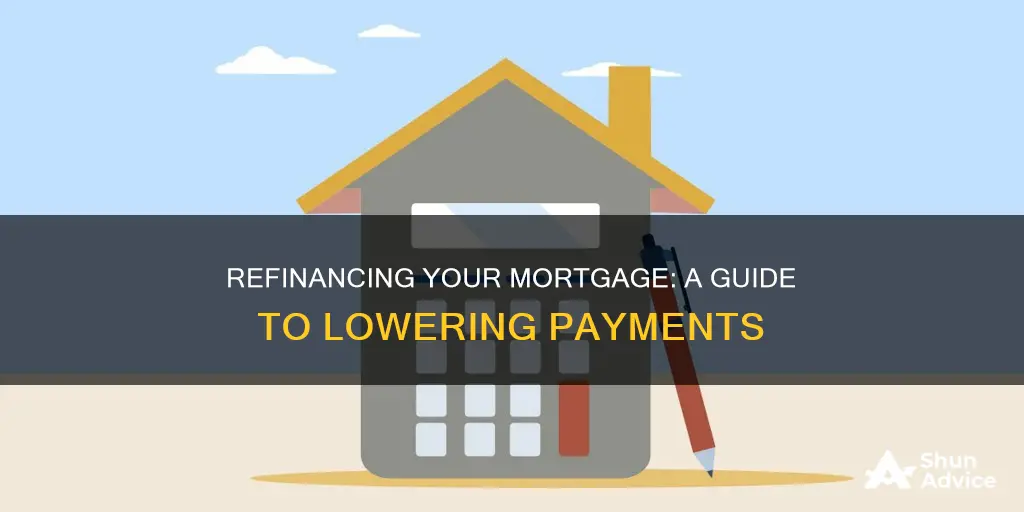
Refinancing a mortgage involves taking out a new loan to pay off your original mortgage loan. This means you're trading in your current mortgage for a new one, often with a new principal and a different interest rate. The new mortgage can be with the same or a different lender, depending on who offers better rates, lower closing costs or fees, and deals. The refinancing process is similar to the home-buying process, and your lender will review your income, assets, debt, and credit score to determine whether you meet the requirements to refinance and can pay back the loan. Once approved, you can choose to lock in your interest rate or float your rate, which means it can fluctuate.

The refinancing process
The process of refinancing a mortgage is similar to the process of obtaining your first mortgage loan. The qualifications for refinancing are also similar to the criteria for a new mortgage loan. Lenders will consider factors such as your credit score, income, assets, debt, and credit history to determine whether you meet the requirements to refinance and can pay back the loan. You'll need to provide documentation to prove your identity, income, and assets, and show that you're able to repay your new mortgage. It's important to shop around and compare each lender's current mortgage interest rates, availability, and client satisfaction scores.
- Set clear financial goals: Figure out what benefits you want from refinancing, such as lowering your monthly payment, reducing interest rates, or owning your home sooner.
- Get multiple rate quotes: Request quotes from at least three lenders within a two-week period to reduce the impact on your credit score.
- Compare rates and fees: Studies show that those who request at least three quotes save an average of $300 a year on their mortgage payments.
- Submit the paperwork: Gather your loan documents and complete your application. You'll need to provide information about yourself, your home, and your existing mortgage loan.
- Schedule a home appraisal: Most lenders require a refinance appraisal to establish your home's current market value.
- Underwriting: The lender will review your financial information and documents to determine whether to approve your loan.
- Closing: Once approved, you'll meet with the lender to sign the paperwork and make everything official. You'll need to pay closing costs, which may include a down payment and other fees.
Mortgage Impact on P&L: A Comprehensive Overview
You may want to see also

Interest rates
Refinancing a mortgage involves taking out a new loan to pay off your original mortgage loan. This means you are trading in your current mortgage for a new one, often with a new principal and a different interest rate. Your lender then uses the new mortgage to pay off the old one, leaving you with a single loan and a single monthly payment.
The interest rate is a key factor when considering refinancing a mortgage. The goal is usually to lower your monthly payment, lower your total amount paid, or both. A lower interest rate will save you money in the short and long term while reducing your monthly payments. For example, a $100,000, 30-year fixed-rate mortgage with an interest rate of 7% has a principal and interest payment of $665. The same loan at 5% reduces the monthly payment to $536.
When interest rates fall, homeowners may have the opportunity to refinance an existing loan for another loan that, without much change in the monthly payment, has a significantly shorter term and can save a considerable amount of interest over time. For instance, if you purchased a $200,000 home with a 20% down payment ($40,000) and a 30-year fixed-rate mortgage for $160,000 at 8%, your monthly payments would be about $1,419, and over the course of the loan, you'd pay $262,648 in interest, making your total repayment $422,648. However, if interest rates drop, you may be able to refinance for a lower interest rate, reducing your monthly payments and freeing up cash for other purposes.
It is important to note that refinancing can cost between 5% and 7% of a loan's principal and requires an appraisal, a title search, and application fees. Therefore, it is crucial to determine if refinancing will save you money by calculating the potential savings. This can be done by comparing your current mortgage terms, interest rate, and payments with the new loan terms, including any associated closing costs. Online mortgage calculators and consultations with mortgage lenders can provide more accurate estimates.
Mortgage Securitization: Benefits for Originators and the Market
You may want to see also

Mortgage types
Refinancing a mortgage involves taking out a new loan to pay off your original mortgage. This is usually done to take advantage of lower interest rates or improve the loan terms, such as the monthly payment or length of the loan. The type of loan a borrower decides to get depends on their needs. Here are some common types of refinancing options:
Rate-and-Term Refinancing
This is the most common type of refinancing. It occurs when the original loan is paid and replaced with a new loan agreement from a lender that comes with a lower interest rate. This type of refinancing allows you to change the interest rate, the loan term, or both.
Cash-Out Refinance
This type of refinance involves taking out a new loan for a larger amount and receiving the difference between the two loan amounts in cash. This increases your mortgage debt but gives you money that you can invest or use for other financial goals, such as home improvements or buying a second home.
Cash-In Refinance
With this option, the borrower will contribute a lump sum toward their mortgage to increase equity and decrease the amount owed. This could result in a lower monthly payment and interest rate.
No-Closing-Cost Refinance
This is a low-cost refinance option where the borrower rolls the closing costs into the principal of the new loan instead of paying them in cash upfront. This results in a higher monthly payment and likely a higher interest rate.
It's important to note that refinancing a mortgage comes with upfront costs, and it's crucial to understand the process and ensure it aligns with your financial goals. It's also a good idea to compare offers from multiple lenders to find the best option for your needs.
Capital Gains and Mortgage: What's the Connection?
You may want to see also

Costs and savings
Refinancing a mortgage involves taking out a new loan to pay off your original mortgage loan. This means you are trading in your current mortgage for a new one, often with a new principal and a different interest rate. Your lender then uses the new mortgage to pay off the old one, leaving you with a single loan and a single monthly payment.
Refinancing your mortgage is not a free process. There are upfront costs and closing costs involved, which typically range from 2% to 6% of the new loan amount. These closing costs may include fees for origination, a home appraisal, and title services. The closing costs for refinancing a $150,000 mortgage, for example, could be anywhere between $3,000 and $9,000.
You can save on the cost of refinancing by improving your credit score, comparing mortgage terms and rates, and negotiating closing costs. It is recommended to calculate the break-even point, which is when your monthly savings surpass the upfront costs. This calculation can help determine if refinancing is worthwhile.
Refinancing can help you secure a lower interest rate, adjust the loan term, or borrow a lump sum through a cash-out refinance. It can also allow you to tap into the equity in your property, providing a way to receive cash if needed. However, this can result in a higher monthly payment and extra interest payments.
Additionally, refinancing may extend the number of years you will be making mortgage payments, as it resets the mortgage duration. For instance, if you refinance after a few years into your initial loan, you may be back to a 30-year loan term.
It is important to note that refinancing can have negative consequences for your credit score, but the long-term benefits can outweigh this temporary downside.
Understanding the Mortgage Process: A Step-by-Step Guide
You may want to see also

Credit checks
Refinancing a mortgage involves taking out a new loan to pay off your original mortgage loan. This is usually done to obtain more favourable terms or interest rates. When you apply to refinance a loan, lenders will review your income, assets, debt and credit score to determine whether you meet the requirements to refinance and can pay back the loan. This is what's known as a hard inquiry on your credit report, and it can cause your credit score to drop slightly.
Lenders will check your credit score and credit history to determine your eligibility for refinancing. If you have a spotless credit history, a solid income and a lot of equity in your home, you may get approved for better terms on a new loan. Credit score requirements vary from lender to lender, but the FHA single-family home loan minimum credit score requirement is 580 for maximum financing (requiring a 3.5% down payment). If your credit score is lower, you may still qualify.
It's important to note that refinancing can negatively impact your credit score, especially if you've been making payments on your current mortgage for a long time. This is because you are taking on a new loan and closing a long-standing credit account, which can lower your credit score. However, as you pay off your new loan over time, your credit score will likely improve as a result of a strong payment history.
To minimise the negative impact on your credit score, it's recommended to do your research and know your score before talking to lenders so that you can compress all inquiries into one short time period. Most credit scoring models treat loan inquiries between a 14-day to 45-day period as one inquiry, minimising the hit to your credit score. Checking your own score does not affect your credit score, so it's a good idea to check your credit score regularly to ensure you're ready for the refinancing process.
Mortgages: Empowering Buyers to Achieve Homeownership Dreams
You may want to see also
Frequently asked questions
Refinancing a mortgage involves taking out a new loan to pay off your original mortgage loan. You are essentially trading in your current mortgage for a new one, often with a new principal and a different interest rate.
There are several reasons why refinancing your mortgage could be beneficial. You can use a refinance to make use of your home's equity, get a better interest rate, and/or lower monthly payment. A refinance could also allow you to remove or add someone to the mortgage.
The process of refinancing a mortgage is similar to the process of obtaining your first mortgage loan. The lender will review your income, assets, debt, and credit score to determine whether you meet the requirements. After approval, you may be given the option to lock your interest rate or float your rate. Once you submit your refinance loan application, the lender begins the underwriting process, verifying your financial information.
The upfront costs required for refinancing may outweigh the benefit of a lower monthly payment. Additionally, refinancing can negatively impact your credit score. It is also important to watch out for prepayment penalties, which can cause problems if you pay off your existing mortgage early or refinance again.







